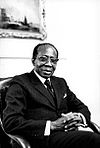塞雷爾人
西非民族
塞雷爾人(法語:Sérères;英語:Serer people),西非民族,依人口計算是塞內加爾的第三大民族,占塞內加爾人口的15%[4]。在岡比亞北部和毛里塔尼亞南部也有分佈[5]。
| 塞雷爾人 | |
|---|---|
  | |
| 總人口 | |
| 180萬以上[1] | |
| 分佈地區 | |
| 184萬 | |
| 53,567[2] | |
| 3,500 | |
| 語言 | |
| 塞雷爾語、昌因語、沃洛夫語 法語(塞內加爾、毛里塔尼亞) 英語(岡比亞) | |
| 宗教信仰 | |
| 伊斯蘭教、基督教、塞雷爾宗教[3] | |
| 相關族群 | |
| 沃洛夫人、喬拉人、圖庫洛爾人、萊布人 | |
塞雷爾人的祖先來自塞內加爾和毛里塔尼亞邊界的塞內加爾河河谷地區,在11世紀至12世紀南遷,15世紀至16世紀因戰亂和宗教壓力再度南遷[6][7][8]。傳統上從事定居農業,精於農耕和移牧式畜牧[7][9]。
塞雷爾人在歷史上長期實行母系制度,抗拒伊斯蘭教傳播,在19世紀起先後和西非的伊斯蘭教聖戰者和法國殖民者對抗[10][11][12]。然而到20世紀,絕大部分塞雷爾人都皈依伊斯蘭教,以蘇菲派為主[13][10]。和塞內加爾的其他民族相似,塞雷爾人的社會也存在着基于氏族內婚和奴隸制度的階級分野[14][15][16]。
名人
編輯- 利奧波德·塞達爾·桑戈爾,塞內加爾首任總統
- 阿卜杜·迪烏夫,塞內加爾第二任總統,法語圈國際組織第二任秘書長
- 馬默·比萊姆·迪烏夫,塞內加爾足球運動員
參考文獻
編輯- ^ Agence Nationale de Statistique et de la Démographie. Estimated figures for 2007 in Senegal alone
- ^ National Population Commission Secretariat. 2013 Population and Housing Census: Spatial Distribution (PDF). Gambia Bureau of Statistics. The Republic of The Gambia. 2005-04-30 [2017-12-29]. (原始內容存檔 (PDF)於2018-01-03).
- ^ Claire L. Adida; David D. Laitin; Marie-Anne Valfort. Why Muslim Integration Fails in Christian-Heritage Societies. Harvard University Press. 2016: 33–34 [2021-02-08]. ISBN 978-0-674-50492-9. (原始內容存檔於2021-04-27).
- ^ Senegal (頁面存檔備份,存於互聯網檔案館), CIA Factsheet
- ^ [1] (頁面存檔備份,存於互聯網檔案館) Ethnologue.com
- ^ Galvan, Dennis Charles, The State Must Be Our Master of Fire: How Peasants Craft Culturally Sustainable Development in Senegal Berkeley, University of California Press, 2004 p. 51
- ^ 7.0 7.1 Elizabeth Berg; Ruth Wan; Ruth Lau. Senegal. Marshall Cavendish. 2009: 63 [2021-02-08]. ISBN 978-0-7614-4481-7. (原始內容存檔於2021-03-03).
- ^ Leonardo A. Villalón. Islamic Society and State Power in Senegal: Disciples and Citizens in Fatick. Cambridge University Press. 2006: 54–55 [2021-02-08]. ISBN 978-0-521-03232-2. (原始內容存檔於2021-03-03)., Quote: "Serer oral tradition recounts the group's origins in the Senegal River valley, where it was part of, or closely related to, the same group as the ancestors of today's Tukulor."
- ^ Natural Resources Research, UNESCO, Natural resources research, Volume 16, Unesco (1979), p. 265
- ^ 10.0 10.1 James Stuart Olson. The Peoples of Africa: An Ethnohistorical Dictionary. Greenwood. 1996: 516 [2021-02-08]. ISBN 978-0-313-27918-8. (原始內容存檔於2020-08-04).
- ^ Pierret, Paul, "Dictionnaire d'archéologie égyptienne", Imprimerie nationale 1875, p. 198-199 [in] Diop, Cheikh Anta, "Precolonial Black Africa", (trans: Harold Salemson), Chicago Review Press, 1988, p. 65
- ^ See Godfrey Mwakikagile in Martin A. Klein. Islam and Imperialism in Senegal Sine-Saloum, 1847–1914, Edinburgh at the University Press (1968)
- ^ Leonardo A. Villalón. Islamic Society and State Power in Senegal: Disciples and Citizens in Fatick. Cambridge University Press. 2006: 71–74 [2021-02-08]. ISBN 978-0-521-03232-2. (原始內容存檔於2020-10-25).
- ^ Danielle Resnick. Urban Poverty and Party Populism in African Democracies. Cambridge University Press. 2013: 165. ISBN 978-1-107-65723-6., Quote:"One reason for the low salience of ethnic identity is because, like some other West African societies, many ethnic groups in Senegal are structured by caste. For example, the Wolof, Serer, and Pulaar-speaking Toucouleur are all caste societies."
- ^ Martin A. Klein. Islam and Imperialism in Senegal: Sine-Saloum, 1847–1914. Stanford University Press. 1968: 7–11. ISBN 978-0-8047-0621-6.
- ^ Tal Tamari. The Development of Caste Systems in West Africa. The Journal of African History (Cambridge University Press). 1991, 32 (2): 221–250. JSTOR 182616. doi:10.1017/s0021853700025718., Quote: "[Castes] are found among the Soninke, the various Manding-speaking populations, the Wolof, Tukulor, Senufo, Minianka, Dogon, Songhay, and most Fulani, Moorish and Tuareg populations, (...) They are also found among (...) and Serer groups."
外部連結
編輯- Moving from Teaching African Customary Laws to Teaching African Indigenous Law (頁面存檔備份,存於互聯網檔案館). By Dr Fatou. K. Camara
- Ethnolyrical. Tassou: The Ancient Spoken Word of African Women (頁面存檔備份,存於互聯網檔案館)
- The Seereer Resource Centre (頁面存檔備份,存於互聯網檔案館)
- Seereer Radio (頁面存檔備份,存於互聯網檔案館)
- Seereer Resource Centre and Seereer Radio Podcast (頁面存檔備份,存於互聯網檔案館)
- Seereer Heritage Press (頁面存檔備份,存於互聯網檔案館)